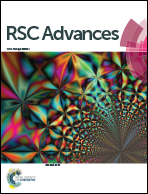A high rectification ratio nanofluidic diode induced by an “ion pool”†
Abstract
Inspired by functionalized biological ion channels, artificial channels were prepared to mimic the natural ones. The key concept behind the rectifying phenomena in nanochannels is the construction of asymmetric restrictive nanochannels. Here, we prepared nanoporous oxidized polyvinyl alcohol (PVA) and WO3 composite coatings on hourglass-shaped anodic aluminum oxide (AAO) nanochannel surfaces. Accordingly, a special “ion pool” is formed between the homogeneous junction in the middle of the AAO and the nanoporous PVA/WO3 film-covered AAO surface and its two ends are greatly nano-confined. Ion enrichment and ion depletion occur in the “ion pool” and are dependant on the applied voltage polarity. A rectification ratio of 458, which is in accordance with the highest value found in previous reports, was obtained from the cooperative effects of the two small open ends of the “ion pool”. Furthermore, this value is enhanced to about 2000 under constant voltage. An excellent pH-sensitive rectification property, with a single rectification direction from acidic to basic conditions, has also been demonstrated.



 Please wait while we load your content...
Please wait while we load your content...